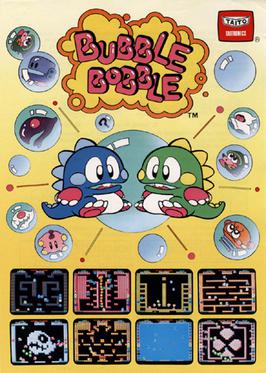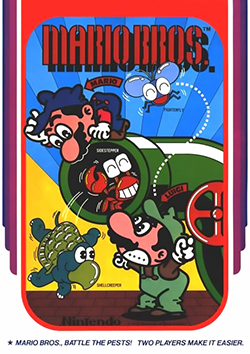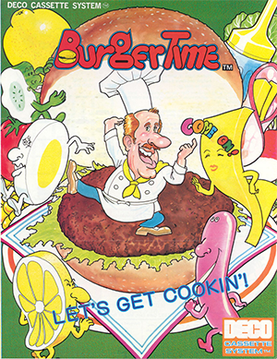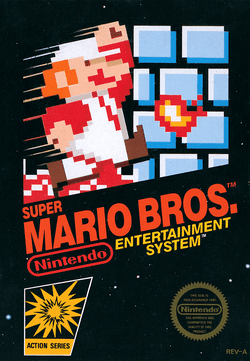
Bubble Bobble is a 1986 platform game developed and published by Taito for arcades. It was distributed in the United States by Romstar, and in Europe by Electrocoin. Players control Bub and Bob, two dragons that set out to save their girlfriends from a world known as the Cave of Monsters. In each level, Bub and Bob must defeat each enemy present by trapping them in bubbles and popping, who turn into bonus items when they hit the ground. There are 100 levels total, each becoming progressively more difficult.

Pac-Man, originally called Puck Man in Japan, is a 1980 maze action video game developed and released by Namco for arcades. In North America, the game was released by Midway Manufacturing as part of its licensing agreement with Namco America. The player controls Pac-Man, who must eat all the dots inside an enclosed maze while avoiding four colored ghosts. Eating large flashing dots called "Power Pellets" causes the ghosts to temporarily turn blue, allowing Pac-Man to eat them for bonus points.

Mario Bros. is a platform game developed and published by Nintendo as an arcade video game in 1983. It was designed by Shigeru Miyamoto and Gunpei Yokoi, Nintendo's chief engineer. Italian twin brother plumbers Mario and Luigi exterminate creatures, like turtles (Koopas) and crabs emerging from the sewers by knocking them upside-down and kicking them away. The Famicom/Nintendo Entertainment System version is the first game produced by Intelligent Systems. It is part of the Mario franchise, but originally began as a spin-off from the Donkey Kong series.

BurgerTime, originally released as Hamburger in Japan, is a 1982 arcade video game from Data East released initially for its DECO Cassette System. The player is chef Peter Pepper, who must walk over hamburger ingredients in a maze of platforms and ladders while avoiding anthropomorphic hot dogs, fried eggs, and pickles which are in pursuit.

Frogger is a 1981 arcade action game developed by Konami and published by Sega. In North America, it was distributed by Sega/Gremlin. The object of the game is to direct five frogs to their homes by dodging traffic on a busy road, then crossing a river by jumping on floating logs and alligators.
Silent Hill is a horror anthology media franchise centered on a series of survival horror games created by Keiichiro Toyama and published by Konami. The first four video games in the series, Silent Hill, Silent Hill 2, Silent Hill 3, and Silent Hill 4: The Room, were developed by an internal group called Team Silent, a development staff within former Konami subsidiary Konami Computer Entertainment Tokyo.

Double Dragon is a beat 'em up video game series originally developed and published by Technōs Japan. It began with the release of the arcade game Double Dragon in 1987. The series features twin martial artists, Billy and Jimmy Lee, as they fight against various adversaries and rivals.
Ace Combat is an arcade-style combat flight simulation video game series by Project Aces, an internal development team of Bandai Namco Entertainment, formerly Namco. Debuting in 1995 with Air Combat for the PlayStation, the series includes eight mainline installments, multiple spin-offs, and other forms of media, such as novels, model kits, and soundtrack albums. Since 2012, the series has been developed primarily by Bandai Namco Studios through its internal development group, Project Aces.

Xevious is a vertically scrolling shooter arcade video game developed and published by Namco in 1982. It was released in Japan by Namco and in North America by Atari, Inc. Controlling the Solvalou starship, the player attacks Xevious forces before they destroy all of mankind. The Solvalou has two weapons at its disposal: a zapper to destroy flying craft, and a blaster to bomb ground installations and enemies. It runs on the Namco Galaga arcade system.

Paperboy is an arcade action game developed and published by Atari Games, and released in 1985. The player takes the role of a paperboy who delivers a fictional newspaper called The Daily Sun along a street on his bicycle. The arcade version of the game featured bike handlebars as the controller.

Tennis is a sports video game developed by Nintendo in 1983, and released for the Family Computer (Famicom) in 1984. The arcade game version Vs. Tennis was also released for the Nintendo VS. System in 1984, becoming a hit at Japanese and American arcades that year; it was the sixth top-performing arcade game of 1984 in the United States. Tennis is one of 17 launch games for the Nintendo Entertainment System (NES) in North America and Europe. The game was re-released for the Game Boy as a launch game in North America.
1996 saw many sequels and prequels in video games, such as Super Mario 64, Duke Nukem 3D, Street Fighter Alpha 2, Super Mario RPG, King's Field III, Virtua Fighter 3, along with new titles such as Blazing Heroes, NiGHTS into Dreams..., Crash Bandicoot, Pokémon Red/Green/Blue, Resident Evil, Dead or Alive, Quake and Tomb Raider.
DDRMAX Dance Dance Revolution 6thMix is the 6th game in the Dance Dance Revolution series of music video games. It was released in the arcades by Konami on October 19, 2001, and for the PlayStation 2 on May 16, 2002, in Japan. 6thMix contains a total of 42 songs, all which made their first arcade appearance on this release. 11 of these songs debuted in various console releases prior to 6thMix. All arcade songs from Dance Dance Revolution to Dance Dance Revolution 5thMix were removed in 6thMix, although many of the Konami originals from those games would later be revived in future arcade releases.

Kiki Kaikai is a shoot 'em up video game developed and published by Taito for arcades in 1986. Set in Feudal Japan, the player assumes the role of a Shinto shrine maiden who must use her o-fuda scrolls and gohei wand to defeat renegade spirits and monsters from Japanese mythology. The game is noteworthy for using a traditional fantasy setting in a genre otherwise filled with science fiction motifs.

Lucky & Wild is a first-person racing/shooter arcade game that was released by Namco in 1993; it ran on Namco System 2 hardware.

Blue Wizard Is About To Die!: Prose, Poems, and Emoto-Versatronic Expressionist Pieces About Video Games (1980-2003) is a volume of verse written by Seth Flynn Barkan in 2003; the title is a phrase heard in the arcade game Gauntlet II. It is reputedly the first volume of poetry dedicated to computer and video games. In part because of its uniqueness and because of reviews in a number of periodicals both in and out of the gaming world, Blue Wizard Is About To Die! "sold more than 5,000 copies internationally, making it one of the best-selling poetry collections of 2004."
Novelists, screenwriters and filmmakers have set their works in Svalbard, an archipelago in the Arctic, the northernmost part of Norway yet closer to Greenland. Such works often make use of its Arctic climate, polar bears, isolation and the natural beauty of its dominant glaciers, mountains and fjords.
Jurassic Park typically refers to the Jurassic Park franchise, a series of books, films, and video games centering around a fictional theme park.

Super Mario Bros. is a platform game developed and published in 1985 by Nintendo for the Famicom in Japan and for the Nintendo Entertainment System (NES) in North America. It is the successor to the 1983 arcade game Mario Bros. and the first game in the Super Mario series. Following a US test market release for the NES, it was converted to international arcades on the Nintendo VS. System in early 1986. The NES version received a wide release in North America that year and in PAL regions in 1987.













